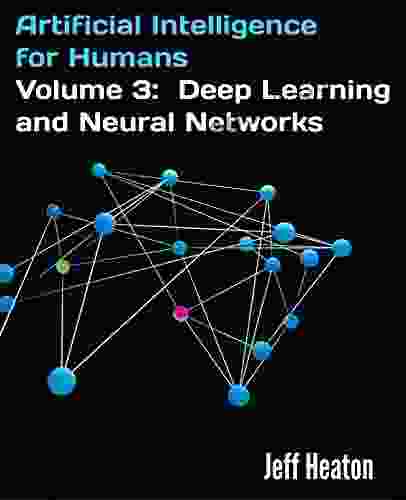Artificial Intelligence for Humans: A Comprehensive Guide for the Curious and Concerned

4 out of 5
| Language | : | English |
| File size | : | 17725 KB |
| Text-to-Speech | : | Enabled |
| Enhanced typesetting | : | Enabled |
| Word Wise | : | Enabled |
| Print length | : | 375 pages |
| Lending | : | Enabled |
| Screen Reader | : | Supported |
Artificial Intelligence (AI) is rapidly reshaping our world. From self-driving cars and facial recognition software to personalized healthcare and predictive analytics, AI is already deeply embedded in our daily lives. As AI continues to advance, it promises to bring even greater benefits, but it also poses significant challenges.
This comprehensive guide aims to demystify AI, exploring its potential benefits and risks, and empowering individuals to navigate the AI landscape with confidence. Whether you're a complete novice or have some familiarity with AI, this guide will provide you with the essential knowledge you need to understand and engage with AI.
What is Artificial Intelligence?
AI is the simulation of human intelligence processes by machines, especially computer systems. AI systems are designed to perform tasks that normally require human intelligence, such as learning, problem-solving, and decision-making.
There are many different types of AI, ranging from simple rule-based systems to complex machine learning algorithms. Some of the most common types of AI include:
- Machine learning: Machine learning algorithms allow computers to learn from data without being explicitly programmed. This allows AI systems to adapt to new situations and improve their performance over time.
- Deep learning: Deep learning is a type of machine learning that uses artificial neural networks to learn complex patterns in data. Deep learning algorithms have achieved state-of-the-art results in a wide range of tasks, including image recognition, natural language processing, and speech recognition.
- Natural language processing: Natural language processing (NLP) is a field of AI that focuses on understanding and generating human language. NLP algorithms can be used for tasks such as machine translation, text summarization, and sentiment analysis.
- Computer vision: Computer vision is a field of AI that focuses on understanding and interpreting images and videos. Computer vision algorithms can be used for tasks such as object recognition, facial recognition, and medical image analysis.
Benefits of Artificial Intelligence
AI has the potential to bring numerous benefits to humanity, including:
- Increased productivity: AI can automate tasks that are currently performed by humans, freeing up time for people to focus on more creative and strategic work.
- Improved efficiency: AI can help businesses and organizations improve their efficiency by automating processes and reducing errors.
- Personalized experiences: AI can be used to provide personalized experiences for customers, such as tailored recommendations, product suggestions, and customer support.
- Improved decision-making: AI can help individuals and organizations make better decisions by providing them with more accurate and timely information.
- New products and services: AI is enabling the development of new products and services that would not be possible without AI, such as self-driving cars and virtual assistants.
Risks of Artificial Intelligence
While AI has the potential to bring numerous benefits, it also poses significant risks, including:
- Job displacement: AI automation could lead to the displacement of millions of jobs, particularly in sectors such as manufacturing, customer service, and transportation.
- Bias: AI systems can be biased, reflecting the biases of the data they are trained on. This can lead to unfair or discriminatory outcomes.
- Security risks: AI systems could be used for malicious purposes, such as cyberattacks and surveillance.
- Loss of privacy: AI systems could be used to collect and analyze personal data without individuals' consent.
- Existential risks: Some experts believe that AI could pose an existential risk to humanity if it is not developed and used responsibly.
AI Ethics and Governance
The development and use of AI raise a number of ethical and governance challenges. These challenges include:
- Ensuring fairness and equity: AI systems must be designed and used in a way that ensures fairness and equity for all.
- Addressing bias: AI systems must be tested for bias and steps must be taken to mitigate any biases that are identified.
- Protecting privacy: AI systems must be designed and used in a way that protects individuals' privacy.
- Establishing accountability: It must be clear who is responsible for the development and use of AI systems.
- Developing international standards: International standards for the development and use of AI are needed to ensure that AI is developed and used in a responsible and ethical manner.
The Future of Artificial Intelligence
The future of AI is uncertain, but it is clear that AI will continue to play an increasingly important role in our lives. AI is already being used in a wide range of applications, and its potential for future applications is vast.
One of the most exciting potential applications of AI is in the field of healthcare. AI can be used to develop new drugs and treatments, diagnose diseases, and provide personalized care.
Another potential application of AI is in the field of climate change. AI can be used to develop new technologies to reduce emissions, predict the impacts of climate change, and help us adapt to the effects of climate change.
It is important to remember that AI is a tool. Like any tool, AI can be used for good or for evil. It is up to us to ensure that AI is used in a way that benefits humanity.
AI is a powerful technology with the potential to bring numerous benefits to humanity. However, it also poses significant risks. It is important to be aware of both the benefits and risks of AI so that we can develop and use AI in a way that maximizes the benefits and minimizes the risks.
This comprehensive guide has provided you with the essential knowledge you need to understand and engage with AI. As AI continues to advance, it is important to stay informed and to participate in the public debate about the future of AI.
4 out of 5
| Language | : | English |
| File size | : | 17725 KB |
| Text-to-Speech | : | Enabled |
| Enhanced typesetting | : | Enabled |
| Word Wise | : | Enabled |
| Print length | : | 375 pages |
| Lending | : | Enabled |
| Screen Reader | : | Supported |
Do you want to contribute by writing guest posts on this blog?
Please contact us and send us a resume of previous articles that you have written.
 Book
Book Novel
Novel Text
Text Story
Story Paragraph
Paragraph Sentence
Sentence Bibliography
Bibliography Preface
Preface Synopsis
Synopsis Scroll
Scroll Codex
Codex Tome
Tome Library card
Library card Narrative
Narrative Autobiography
Autobiography Memoir
Memoir Reference
Reference Encyclopedia
Encyclopedia Thesaurus
Thesaurus Narrator
Narrator Character
Character Librarian
Librarian Card Catalog
Card Catalog Borrowing
Borrowing Archives
Archives Study
Study Research
Research Lending
Lending Reserve
Reserve Academic
Academic Journals
Journals Reading Room
Reading Room Special Collections
Special Collections Interlibrary
Interlibrary Literacy
Literacy Thesis
Thesis Storytelling
Storytelling Awards
Awards Reading List
Reading List Theory
Theory Genevieve Stebbins
Genevieve Stebbins Serge Alfonse
Serge Alfonse Dean Feldmeyer
Dean Feldmeyer Alex Kuczynski
Alex Kuczynski Katherine Garbera
Katherine Garbera Chris Blake
Chris Blake Luke Connery
Luke Connery Laurie Kaplan
Laurie Kaplan Gary Y Okihiro
Gary Y Okihiro Alex Dancyg
Alex Dancyg Megan Angelo
Megan Angelo Emily D Edwards
Emily D Edwards John Lukacs
John Lukacs Kj Dell Antonia
Kj Dell Antonia John Marciano
John Marciano Steve Bockman
Steve Bockman Mary Carolyn Waldrep
Mary Carolyn Waldrep H M Sealey
H M Sealey Stephen Marsland
Stephen Marsland Timothy Gordon
Timothy Gordon
Light bulbAdvertise smarter! Our strategic ad space ensures maximum exposure. Reserve your spot today!

 Brayden ReedGo Fractions with Penguin Young Readers Level: Unlock Math Mastery for Young...
Brayden ReedGo Fractions with Penguin Young Readers Level: Unlock Math Mastery for Young...
 Kurt VonnegutBrown Boy Brown Boy What Can You Be? Exploring Identity and Empowerment in...
Kurt VonnegutBrown Boy Brown Boy What Can You Be? Exploring Identity and Empowerment in...
 Hayden MitchellThe Boundless Sea of Self and History: A Journey of Exploration and Discovery
Hayden MitchellThe Boundless Sea of Self and History: A Journey of Exploration and Discovery Casey BellFollow ·14.7k
Casey BellFollow ·14.7k Federico García LorcaFollow ·16.5k
Federico García LorcaFollow ·16.5k Dwight BellFollow ·19k
Dwight BellFollow ·19k Ernest HemingwayFollow ·9.6k
Ernest HemingwayFollow ·9.6k Jamal BlairFollow ·7.3k
Jamal BlairFollow ·7.3k Elliott CarterFollow ·10.4k
Elliott CarterFollow ·10.4k Russell MitchellFollow ·13.3k
Russell MitchellFollow ·13.3k Fred FosterFollow ·8.6k
Fred FosterFollow ·8.6k

 Gary Reed
Gary ReedWeb to Web for Beginners: A Comprehensive Guide to...
In today's interconnected world, websites...

 Elliott Carter
Elliott CarterThe Moon Is Down: John Steinbeck's Poignant Portrait of...
In the annals of literature, John...

 Dalton Foster
Dalton FosterMark The Mechanic: The Incredible Story Of A Young...
In the vibrant realm of robotics, where...

 Fred Foster
Fred FosteriPhone 13 Pro Max User Guide: Everything You Need to Know
The iPhone 13 Pro Max...

 Rodney Parker
Rodney ParkerPope John Paul II: The Pocket Giant Who Inspired Millions
Pope John Paul II, or...
4 out of 5
| Language | : | English |
| File size | : | 17725 KB |
| Text-to-Speech | : | Enabled |
| Enhanced typesetting | : | Enabled |
| Word Wise | : | Enabled |
| Print length | : | 375 pages |
| Lending | : | Enabled |
| Screen Reader | : | Supported |







